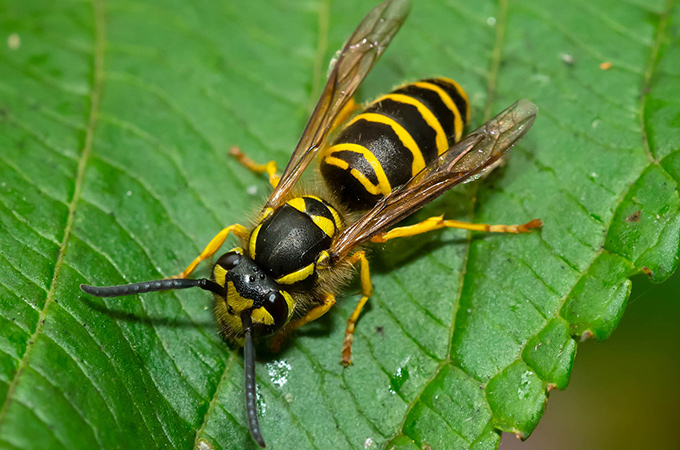One question we hear a lot from our clients is “I know bees are good for the environment, but what about wasps?” Well, wasps are still an important part of our ecosystem, and can help with pest control and pollination, but they get a bad rap compared to their relative the honeybee for their more aggressive nature and painful stings. So today, let’s learn all about wasps so you can be prepared for your next encounter!
Wasp Basics
Wasps are flying insects that belong to the order Hymenoptera, which also includes bees and ants. They have slender bodies divided into three sections: head, thorax, and abdomen, with a pinched waist between the thorax and abdomen, and two pairs of wings. They’re most known for their distinctive yellow and black stripes, but the color can vary depending on the species, including white, brown, red, or even blue!
Similar to termites and ants, they have caste systems which include queens, workers, and drones. Workers are non-reproductive females that forage for food and maintain the colony. Drones are males who seek out new queens to mate with. The queens lay eggs and establish new colonies. Their size will depend on their caste and species, but typically they’re around a half inch to one and a half inches long. Workers and drones usually live for a few weeks to a few months and die naturally in the late summer and early fall while queens can live up to a year and hibernate during the winter. Sometimes wasps can be solitary and will go off on their own without being attached to a nest or colony.
Common Types of Wasps in Florida
Florida is home to over 200 species of wasps, but here’s an overview of the most common ones you’ll find buzzing about.
Mud Wasps/Daubers: Mud wasps, aka mud daubers, are solitary wasps, so each female will build their own small, tubular nest out of mud, attached to sheltered areas like eaves, walls, and ceilings. They are about one inch in length and are black, metallic blue, or black and yellow in color. They primarily hunt spiders and are usually not aggressive toward humans.

Paper Wasps: Paper wasps, named after their nests, construct nests created by chewing wood fibers. They are social and will live in colonies with a queen. The nests are umbrella-shaped, with a comb of hexagonal cells suspended by a short stalk. Nests are often built in sheltered locations such as under eaves, in attics, or on tree branches. They’re generally not as aggressive as yellow jackets or hornets but will defend their nests if threatened. If you spot a nest, it’s best to call a pest control professional to remove it safely.

Ground Wasps/Yellowjackets: The most infamous wasp, the yellowjacket, is known for building their nests underground, earning the title of a ground wasp.They’re instantly recognizable for their yellow and black markings. They also live in colonies and paper material nests that are built underground, often in abandoned rodent burrows or other cavities, or in wall voids, attics, crawl spaces, and other enclosed areas. Yellowjackets are well known for their aggressive behavior when their nest is threatened, so don’t try to remove a nest on your own. They are also attracted to sweet foods and meats, so they’ll often be attracted to humans when hanging out outside.

Wasps vs Bees vs Hornets
Bzzz. What was that? Here’s a quick primer on the difference between wasps, bees, and hornets. Bees have the classic round and fuzzy shape as opposed to the slim and slender shape of wasps. Wasps are predators that feed on other insects, and bees are primarily herbivores, feeding on nectar and pollen from flowers. While wasps build their nests from paper or mud, bees construct nests from wax to store their honey. Bees are also less aggressive and will only sting as a last resort. So don’t swat away a curious bee! Let them continue their pollination.
Hornets, on the other hand, are larger and more aggressive than wasps. Hornets are about 2 inches long with a robust body and wide head. They have an oval-shaped abdomen attached to the thorax by a slender waist and have six legs, two pairs of wings, and a pair of antennae. Hornets build large, enclosed paper nests that can house thousands of colony members. Nests are often found high up in trees or buildings, and should only be handled by a professional.

Tips for Spotting Wasp Nests
If you see a lot of wasps flying around your yard or disturbing your outdoor gatherings, here are some tips for finding their nests.
- Inspect the outside of your house for mud tubes on eaves, walls, and ceiling/roof. If you see mud wasps, check around garages, sheds, barns, and other outdoor structures.
- Look for paper nests in tree branches, fences, or playgrounds.
- Look for any holes in your lawn, soil, garden, and around the base of trees or shrubs.
- You can observe the flight paths of wasps to help locate the nest entrance. Wasps are most active in the afternoon, between 12-4 PM.
- Always be cautious and if you do find a nest be careful not to disturb it and call a professional as soon as you can.

How to Prevent Wasps
Here are some best practices for preventing wasps and keeping your house and yard free of wasp nests.
- Inspect the exterior of your home and seal any entry points using caulk, foam sealant, or mesh screens.
- Clean and tidy outdoor spaces by removing debris, woodpiles, or overgrown vegetation. Trim back any trees or shrubs that touch your home. Remove tall grass and weeds, and try to eliminate sources of water.
- Clean up food debris and keep garbage and recycling cans sealed.
- Try using natural repellents like peppermint, eucalyptus, or lemongrass essential oils.
- Regularly inspect your property for signs of wasp activity or nest building, especially in the spring as the queens are setting up their new colonies.
If you see a wasp nest in your yard, don’t panic. Just call your friends at Nozzle Nolen and we’ll handle it for you. With our 365 Complete Plan, we’ll carefully monitor your property year-round and remove small nests before they become big ones. That means you can relax and enjoy your yard without fear!




